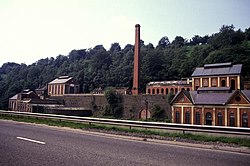Crumlin, Monmouthshire: Difference between revisions
Created page with '{{Infobox town |name=Crumlin |welsh=Crymlyn |county=Monmouthshire |picture=Swffryd - geograph.org.uk - 108420.jpg |picture caption=Swffryd, with Crumlin beneath |os grid ref=ST21…' |
No edit summary |
||
| (2 intermediate revisions by the same user not shown) | |||
| Line 3: | Line 3: | ||
|welsh=Crymlyn | |welsh=Crymlyn | ||
|county=Monmouthshire | |county=Monmouthshire | ||
|picture= | |picture=Crumlin Navigation Colliery - geograph.org.uk - 755038.jpg | ||
|picture caption= | |picture caption=The former Navigation Colliery | ||
|os grid ref=ST213989 | |os grid ref=ST213989 | ||
|latitude=51.683869 | |latitude=51.683869 | ||
| Line 16: | Line 16: | ||
|constituency=Islwyn | |constituency=Islwyn | ||
}} | }} | ||
'''Crumlin''' is a village in [[Monmouthshire]] tucked into | '''Crumlin''' is a village in [[Monmouthshire]] tucked into Ebbw Vale, an industrial town as ever it was. It is on the east bank of the [[River Ebbw]], pressed narrowly against the steep slopes of the valleys in the elbow between the Ebbw and a lesser stream running out of the mountains. | ||
[[ | [[Swffryd]] is above Crumlin and across the Ebbw is [[Rhiw, Monmouthshire|Rhiw]]. [[Newbridge, Monmouthshire|Newbridge]] lies a mile downstream, due south, while [[Pontypool]] lies five miles eastward. | ||
==Crumlin Viaduct== | ==Crumlin Viaduct== | ||
Crumlin is famous for railway viaduct which long stood here soaring over the vale. At 200 feet high and 1,650 feet in length in two spans ( | Crumlin is famous for railway viaduct which long stood here soaring over the vale. At 200 feet high and 1,650 feet in length in two spans (1,066 feet and 584 feet) it remained the highest railway viaduct in [[Great Britain]] throughout its working life. Work by the designer and contractor Thomas W Kennard commenced in autumn 1853. | ||
The viaduct was opened in June 1857 for the Taff Vale Extension to the Newport, Abergavenny and Hereford Railway. Nearby were the two railway stations, both at high (viaduct) and valley levels. | The viaduct was opened in June 1857 for the Taff Vale Extension to the Newport, Abergavenny and Hereford Railway. Nearby were the two railway stations, both at high (viaduct) and valley levels. | ||
| Line 28: | Line 28: | ||
==Historic industry== | ==Historic industry== | ||
Crumlin was the northern terminus of the Crumlin Arm of the Monmouthshire Canal. The canal was built from Crumlin southwards towards [[Newport, Monmouthshire]], opening in 1794, but not completed at [[Fourteen Locks]] until 1799. Tramroads from the ironworks at Ebbw Vale and Nantyglo were built to the canal at Crumlin basin, where the iron was transhipped into canal boats. | Crumlin was the northern terminus of the Crumlin Arm of the Monmouthshire Canal. The canal was built from Crumlin southwards towards [[Newport, Monmouthshire|Newport]], opening in 1794, but not completed at [[Fourteen Locks]] until 1799. Tramroads from the ironworks at Ebbw Vale and Nantyglo were built to the canal at Crumlin basin, where the iron was transhipped into canal boats. | ||
When the railway viaduct was built, the canal was shortened as one of the pillars needed to be located in its path. The canal is no longer in evidence as it was filled in the late 1960s for the construction of the A467 road. | When the railway viaduct was built, the canal was shortened as one of the pillars needed to be located in its path. The canal is no longer in evidence as it was filled in the late 1960s for the construction of the A467 road. | ||
The Crumlin Viaduct Works Company Limited produced the ironwork for the Crumlin Viaduct, they also produced the ironwork for the first Blackfriars Railway Bridge for the London, Chatham and Dover Railway, 120 bridges in Buenos Aires, Argentina, 69 bridges for the Rome and Ancona Railway in Italy, | The Crumlin Viaduct Works Company Limited produced the ironwork for the Crumlin Viaduct, they also produced the ironwork for the first Blackfriars Railway Bridge for the London, Chatham and Dover Railway, 120 bridges in Buenos Aires, Argentina, 69 bridges for the Rome and Ancona Railway in Italy, five multi-span bridges for railways in India, a 17-span bridge in Pernambuco, Brazil as well as bridges in [[New Ross]], Co. Wexford, the Murray River in Australia and Wolkoff for the Great Russian Railway. | ||
The Navigation Colliery was in Crumlin. Sinking commenced in 1907 and completed in 1911, and it was finally closed in 1967.<ref>[http://www.bbc.co.uk/wales/coalhouse/sites/mines/pages/crumlin_navigation_colliery.shtml Details at BBC Coal House site]</ref> Some mine buildings remain preserved to the north of the town. | The Navigation Colliery was in Crumlin. Sinking commenced in 1907 and completed in 1911, and it was finally closed in 1967.<ref>[http://www.bbc.co.uk/wales/coalhouse/sites/mines/pages/crumlin_navigation_colliery.shtml Details at BBC Coal House site]</ref> Some mine buildings remain preserved to the north of the town. | ||
Latest revision as of 16:21, 10 March 2016
| Crumlin Welsh: Crymlyn | |
| Monmouthshire | |
|---|---|
 The former Navigation Colliery | |
| Location | |
| Grid reference: | ST213989 |
| Location: | 51°41’2"N, 3°8’21"W |
| Data | |
| Population: | 5,724 (2001) |
| Post town: | Newport |
| Postcode: | NP11 |
| Dialling code: | 01495 |
| Local Government | |
| Council: | Caerphilly |
| Parliamentary constituency: |
Islwyn |
Crumlin is a village in Monmouthshire tucked into Ebbw Vale, an industrial town as ever it was. It is on the east bank of the River Ebbw, pressed narrowly against the steep slopes of the valleys in the elbow between the Ebbw and a lesser stream running out of the mountains.
Swffryd is above Crumlin and across the Ebbw is Rhiw. Newbridge lies a mile downstream, due south, while Pontypool lies five miles eastward.
Crumlin Viaduct
Crumlin is famous for railway viaduct which long stood here soaring over the vale. At 200 feet high and 1,650 feet in length in two spans (1,066 feet and 584 feet) it remained the highest railway viaduct in Great Britain throughout its working life. Work by the designer and contractor Thomas W Kennard commenced in autumn 1853.
The viaduct was opened in June 1857 for the Taff Vale Extension to the Newport, Abergavenny and Hereford Railway. Nearby were the two railway stations, both at high (viaduct) and valley levels.
The viaduct closed in 1964 under the Beeching Axe. Plans for preservation were discussed, but the poor state of repair made this impossible, and the viaduct was dismantled in 1967. Even while demolition work was in progress, scenes for the film Arabesque which starred Sophia Loren and Gregory Peck were being shot on it. As of 2008 the abutments remain visible on the valley sides adjoining the delightful Kier Hardie Terrace.
Historic industry
Crumlin was the northern terminus of the Crumlin Arm of the Monmouthshire Canal. The canal was built from Crumlin southwards towards Newport, opening in 1794, but not completed at Fourteen Locks until 1799. Tramroads from the ironworks at Ebbw Vale and Nantyglo were built to the canal at Crumlin basin, where the iron was transhipped into canal boats.
When the railway viaduct was built, the canal was shortened as one of the pillars needed to be located in its path. The canal is no longer in evidence as it was filled in the late 1960s for the construction of the A467 road.
The Crumlin Viaduct Works Company Limited produced the ironwork for the Crumlin Viaduct, they also produced the ironwork for the first Blackfriars Railway Bridge for the London, Chatham and Dover Railway, 120 bridges in Buenos Aires, Argentina, 69 bridges for the Rome and Ancona Railway in Italy, five multi-span bridges for railways in India, a 17-span bridge in Pernambuco, Brazil as well as bridges in New Ross, Co. Wexford, the Murray River in Australia and Wolkoff for the Great Russian Railway.
The Navigation Colliery was in Crumlin. Sinking commenced in 1907 and completed in 1911, and it was finally closed in 1967.[1] Some mine buildings remain preserved to the north of the town.
The Mine Rescue Station was opened in Station Road, Crumlin in 1910 and closed in 1986. It was the first in the South Wales Coalfield.[2]
In 1914 the South Wales and Monmouthshire School of Mines at Treforest established a sister school for part-time students at Crumlin Hall, which later became the Crumlin Mining and Technical College. Crumlin Hall was previously Thomas Kennard's home.[3]
The Crumlin Mural
The Crumlin Mural is a rather unusual and well executed mural in the town centre which depicts the history of the town and the Ebbw Valley. The Viaduct is shown running along the top of a number of the panels.
- The Mural
New industries
Crumlin is the base for Brace's Bakery, a third-generation owned family bakery.
In the 1980s, Marcheast Ltd. made the Land Master, a four-wheel drive vehicle at Crumlin.[1]
Conway Stewart, the pen manufacturer relocated to Crumlin in 1968, but the plant was closed in 1975.
Crumlin is home to the popular snack, Pot Noodle. As of 2006 it appeared in a series of TV adverts for the product. The main manufacturing plant, offices and distribution centre are situated there.
Sport
- Cricket: Crumlin Cricket Club
- Rugby union: Crumlin RFC, founded in 1880.
Outside links
- Old photos of Crumlin
- One person's memories of Crumlin on the BBC Wales website
- Crumlin Viaduct website
- Crumlin Mural Panorama




